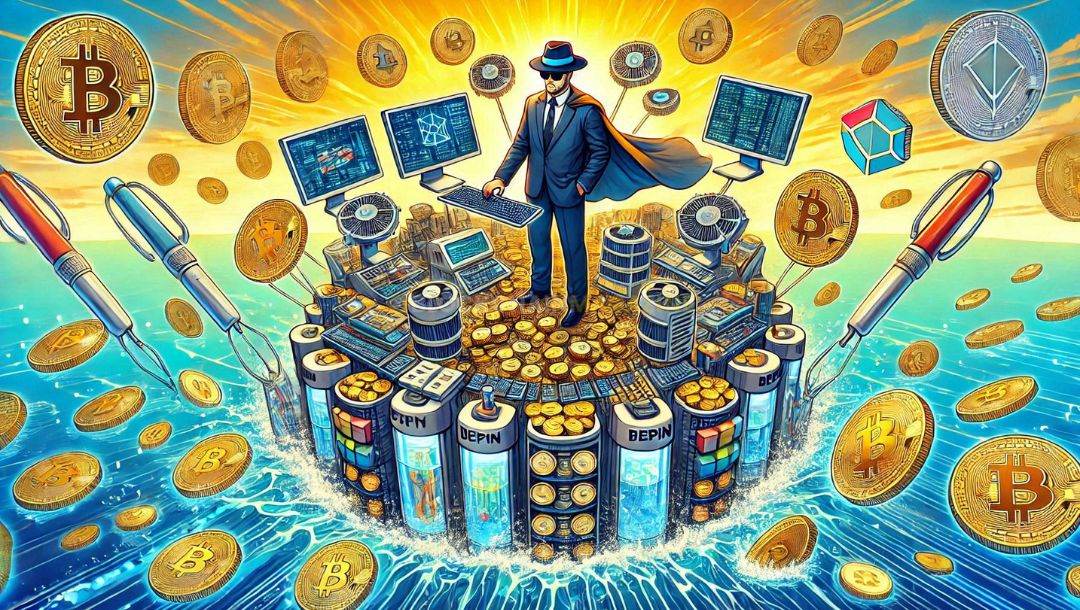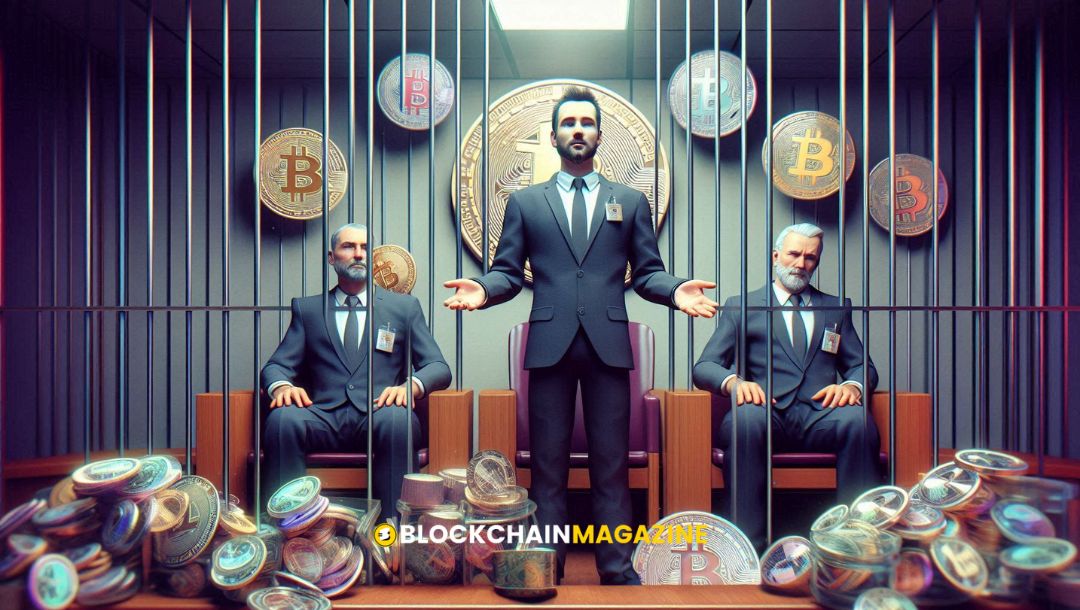What is DePin Crypto? Top 7 Coins You Need to Know About
Ever heard of DePin crypto? It’s short for Decentralized Physical Infrastructure Networks. These projects are shaking things up by using blockchain to change how real-world infrastructure works. Think of it like taking the power from big corporations and giving it to regular people. From storage to streaming, DePin is all about making things more open and fair. If you’re curious about what’s hot in this space, here are seven coins you should know about.
Key Takeaways
- DePin crypto is about decentralizing physical infrastructure using blockchain.
- It aims to give control back to the community instead of central authorities.
- Projects like Filecoin and Render are leading the charge in this space.
- These coins offer new ways to manage resources like storage and internet access.
- Understanding DePin can open up new investment opportunities.
1. Chirp
Chirp is making waves in the DePIN world as a decentralized network focused on telecommunications and IoT connections. Built on the Sui blockchain, it aims to solve the fragmentation in IoT systems by enabling seamless connectivity among devices from different manufacturers like Samsung, Microsoft, and Google.
Why Chirp Stands Out:
- Decentralized Network: Chirp operates a decentralized telecommunications network, allowing users to run devices from their homes and earn CHIRP tokens as rewards.
- Token Growth: The CHIRP token has already seen a significant increase in value, rising over 300% in presale, highlighting its potential in the market.
- Pioneering P2E Game: Chirp is introducing Kage, the first DePIN play-to-earn game on Sui, where users can earn tokens by mapping their environment.
Chirp’s approach combines IoT connectivity with gaming, offering users a unique way to engage with technology while earning rewards. This could potentially transform how we interact with IoT devices, making everyday tech use more interconnected and rewarding.
Chirp is not just another crypto project; it’s a step towards a more connected digital world. By incentivizing participation through token rewards, it empowers users to contribute to a global IoT network, enhancing connectivity and utility in everyday life.
Key Features of Chirp
- IoT Connectivity: Bridges the gap between different IoT ecosystems, facilitating better communication and integration.
- User Incentives: Rewards users with tokens for their participation, encouraging widespread adoption and network growth.
- Innovative Gaming Integration: Introduces real-world utility in gaming through its P2E model, merging tech interaction with entertainment.
Chirp is a noteworthy player in the DePIN sector, aiming to redefine how IoT systems operate and interact. Its innovative approach and early success in token presales position it as a promising project to watch.
2. Render
Render Network is like a matchmaker for creators and GPU providers. This decentralized platform connects those who need rendering services with people who have spare GPU power. By utilizing unused GPU resources, Render offers scalable and budget-friendly rendering solutions. Whether it’s for 3D graphics, animations, or virtual reality content, Render makes powerful rendering more accessible.
In 2024, Render made a big leap from Ethereum to Solana, renaming its token from RNDR to RENDER. This shift was all about boosting transaction speed and scalability. Major exchanges supported this transition, and it went smoothly with a 1:1 token swap. Throughout the year, Render’s user base grew, showing its increasing popularity among creatives and tech enthusiasts.
Render’s native token, RENDER, has seen a lot of market action. Over the past year, its value jumped over 150%. Predictions suggest that it could hit an average price of $7.51 in 2024, with more gains on the horizon.
Key Features
- Decentralized GPU Network: Render provides a platform where GPU providers and users can connect directly.
- Token Rewards: Users renting out their GPU power earn RENDER tokens, creating an incentive to participate.
- Scalability and Speed: With its move to Solana, Render has improved its transaction capabilities significantly.
Render Network opens up high-performance rendering to a wider audience, breaking down barriers and democratizing access to advanced GPU resources.
For those interested in the latest market trends and price updates, the Render (ERC-20) price is currently R$44.20 in Brazil. Keeping an eye on these trends can offer insights into the potential growth and opportunities within the Render ecosystem.
3. BitTorrent
BitTorrent, a name that’s been around since the early 2000s, has evolved from its original software into a fully decentralized platform. Purchased by TRON in 2018, BitTorrent now allows users to share files directly without the need for a central server. This transformation has made it a key player in the decentralized file-sharing space.
Key Features of BitTorrent
- Decentralized File Sharing: Users can share music, videos, and images efficiently.
- Incentive System: Participants are rewarded with BTT tokens for sharing files.
- Cross-Platform Availability: Accessible via Windows, Mac, and Android, although iOS support is still pending.
Market Performance
BitTorrent’s native token, BTT, has seen significant growth, with an 85% increase over the past year. Despite trading 62% below its all-time high, BitTorrent maintains a market cap of over $1.1 billion, indicating potential for future expansion.
BitTorrent’s journey from a simple file-sharing tool to a decentralized powerhouse is a testament to the changing landscape of digital content distribution.
For those interested in memecoin trading, platforms like Bybit and Binance are popular choices, offering features that align well with the dynamic nature of tokens like BTT.
4. Filecoin
Filecoin is like the Airbnb of data storage, but instead of renting out rooms, you’re renting out digital storage space. It’s a decentralized storage network that lets people store, retrieve, and host data in a peer-to-peer fashion. By using blockchain technology, Filecoin creates an open marketplace where storage providers and clients can transact directly. This ensures that data is stored securely and verifiably over time.
How It Works
- Storage Providers: These are the folks who offer their hard drive space to the network. They get paid by users who need to store their files.
- Clients: These are the users who need storage space. They pay providers to keep their data safe and sound.
- Blockchain Verification: The system continuously checks that files are stored correctly, ensuring everything is legit.
Recent Developments
In 2024, Filecoin expanded its ecosystem significantly. The introduction of the Filecoin Virtual Machine (FVM) has opened up new possibilities, like on-chain payments and better access to collateral markets. This move has pushed the Total Value Locked (TVL) to over $200 million. However, despite these advancements, the price of FIL tokens hasn’t seen a huge jump, staying below its March 2024 peak of $11.47.
Market Performance
- Market Cap: Around $3.26 billion as of November 2024.
- 12-Month Performance: FIL has risen by approximately 19.02% over the past year.
- All-Time High: The token hit a peak of $237.24, which seems like a distant memory now.
Filecoin’s journey in the decentralized storage space is a testament to how blockchain can revolutionize traditional industries. By empowering users to control their data, it’s paving the way for a more open and efficient future.
For those looking at investment opportunities, Dogecoin’s potential gains in the upcoming bull run might be worth considering alongside Filecoin’s steady growth.
5. Theta Network
Theta Network is shaking things up in the video streaming world by using blockchain to make things more fair and efficient. It’s not just another streaming platform—it’s a whole new way to think about delivering content. At its core, Theta lets users share their extra bandwidth and computing power, which helps improve streaming quality and cut down costs for content creators.
The network operates with two main tokens: THETA, which is used for governance, and TFUEL, which powers transactions and rewards users who contribute their resources. This dual-token system is pretty clever because it keeps things running smoothly while incentivizing participation.
Theta has been making some big moves lately. In 2024, they rolled out EdgeCloud, which is a next-gen edge network solution. This combines the cloud and edge computing to support new applications in video and AI. It’s like creating a global computing grid powered by a community of node operators and infrastructure providers.
Here’s what makes Theta stand out:
- Decentralized Video Streaming: By using blockchain, Theta provides a censorship-resistant network for video streaming, making it a solid alternative to platforms like YouTube.
- Incentive System: Users can earn TFUEL by sharing their bandwidth, which is a neat way to get more people involved.
- Global Reach: With a community of node operators worldwide, Theta is building a network that’s both robust and expansive.
Theta Network is more than just a platform; it’s a community-driven ecosystem that’s changing how we think about video content delivery.
Looking ahead, Theta plans to launch EdgeCloud Phase 3 in 2025, featuring an open marketplace that connects clients with edge nodes run by community members. This step is crucial for creating a global computing grid, marking Theta as a key player in the Decentralized Physical Infrastructure Network (DePIN) sector.
For those keeping an eye on the crypto market, Theta’s developments make it one of the best cryptocurrencies for potential gains in 2025. With its innovative approach and solid growth, it’s definitely one to watch.
6. MultiversX
MultiversX is a unique player in the world of decentralized infrastructure, offering a wide array of services that span across DePIN, decentralized finance, and the Internet of Things. The platform’s proprietary blockchain infrastructure is capable of handling up to 100,000 transactions per second, with transaction costs as low as $0.002. This makes it incredibly efficient for micro-transactions.
Key Features of MultiversX
- Scalability: With the ability to process a massive number of transactions quickly, MultiversX is ideal for large-scale applications.
- Cost-Effective: Low transaction fees make it accessible for a variety of uses, from small businesses to large enterprises.
- Smart Contracts: Automation through smart contracts enables efficient and secure transactions.
Use Cases
- Financial Services: MultiversX can transform traditional lending by enabling collateralized stablecoin loans, particularly in regions like Africa where access to financial services can be limited. Transactions are automated via smart contracts, ensuring transparency and efficiency.
- Data Integrity: Leveraging ZK technology, MultiversX can detect false information and deep fakes, ensuring data accuracy.
MultiversX’s native token, EGLD, is essential for transactions within its ecosystem. While it has faced a 5% loss over the past year, it remains a critical component of the network.
Despite its challenges, MultiversX continues to play a vital role in the DePIN landscape, offering robust solutions that cater to both online and offline initiatives.
7. Ocean Protocol
Ocean Protocol is a decentralized data exchange protocol that plays a crucial role in the digital economy by enabling secure and transparent sharing of data. Its primary aim is to facilitate the use of data in a way that supports artificial intelligence and machine learning applications.
Key Features of Ocean Protocol
- Data Tokenization: Ocean Protocol allows data to be tokenized, turning datasets into assets that can be traded on the blockchain. This process enhances data availability and liquidity.
- Decentralized Marketplace: It provides a decentralized marketplace where data providers and consumers can interact directly, eliminating the need for centralized data brokers.
- Privacy and Security: The protocol ensures that data privacy is maintained while still allowing access to valuable datasets. This is achieved through advanced encryption techniques and access control mechanisms.
How Ocean Protocol Works
- Data Providers: Individuals or organizations that own data can tokenize their datasets and list them on the Ocean marketplace.
- Data Consumers: Researchers, developers, and businesses can purchase access to these datasets using Ocean tokens.
- Smart Contracts: Transactions are managed by smart contracts, ensuring transparency and trust between parties.
Ocean Protocol is transforming how data is shared and utilized, paving the way for new innovations in AI and machine learning.
Benefits of Using Ocean Protocol
- Increased Data Accessibility: By decentralizing data exchange, Ocean Protocol makes data more accessible to a wider audience.
- Enhanced Data Monetization: Data owners can monetize their data without compromising privacy or control.
- Support for AI Development: By providing access to diverse datasets, Ocean Protocol supports the development of AI technologies.
Ocean Protocol is a decentralized data exchange protocol that supports AI by facilitating access to data. It consists of a live tech stack and aims to enhance data sharing and utilization. This innovative approach not only democratizes data access but also opens up new opportunities for data-driven innovations.
Wrapping It Up: DePin and the Future of Crypto
So, there you have it. DePin is not just a buzzword; it’s a whole new way of thinking about infrastructure and crypto. These projects are shaking things up by decentralizing everything from internet access to cloud storage. It’s like giving power back to the people, one blockchain at a time. If you’re looking to get into the crypto game, keeping an eye on DePin coins might just be your ticket. They’re not just about making a quick buck; they’re about being part of something bigger. So, whether you’re a seasoned investor or just crypto-curious, DePin is definitely worth a look. Who knows? You might just find the next big thing in this ever-evolving world of digital currency.
Frequently Asked Questions
What is DePIN?
DePIN stands for Decentralized Physical Infrastructure Networks. It’s a way to use blockchain to manage real-world systems like the internet, energy, and data storage without a central authority.
How does DePIN work?
DePIN uses blockchain technology to let people share resources like storage and internet access. Participants earn tokens for helping out, making the system fair and rewarding.
Why are DePIN coins important?
DePIN coins are crucial because they power these decentralized networks. They reward users for their contributions and help keep the network running smoothly.
Which are the top DePIN coins?
Some of the top DePIN coins include Chirp, Render, BitTorrent, Filecoin, Theta Network, MultiversX, and Ocean Protocol.
Can DePIN coins be a good investment?
Investing in DePIN coins can be promising as they represent a growing trend in decentralizing infrastructure. However, like all investments, they come with risks.
How do I earn DePIN coins?
You can earn DePIN coins by contributing resources like bandwidth or storage to the network. In return, the network rewards you with its native tokens.
Stay informed with daily updates from Blockchain Magazine on Google News. Click here to follow us and mark as favorite: [Blockchain Magazine on Google News].
Get Blockchain Insights In Inbox
Stay ahead of the curve with expert analysis and market updates.
latest from tech
Disclaimer: Any post shared by a third-party agency are sponsored and Blockchain Magazine has no views on any such posts. The views and opinions expressed in this post are those of the clients and do not necessarily reflect the official policy or position of Blockchain Magazine. The information provided in this post is for informational purposes only and should not be considered as financial, investment, or professional advice. Blockchain Magazine does not endorse or promote any specific products, services, or companies mentioned in this posts. Readers are encouraged to conduct their own research and consult with a qualified professional before making any financial decisions.

 Bitcoin
Bitcoin  Ethereum
Ethereum  Tether
Tether  XRP
XRP  Solana
Solana  Dogecoin
Dogecoin  USDC
USDC  Cardano
Cardano  Lido Staked Ether
Lido Staked Ether  TRON
TRON  Avalanche
Avalanche  Sui
Sui  Wrapped stETH
Wrapped stETH  Toncoin
Toncoin  Shiba Inu
Shiba Inu  Chainlink
Chainlink  Stellar
Stellar  Wrapped Bitcoin
Wrapped Bitcoin  Hedera
Hedera  Polkadot
Polkadot  WETH
WETH  Bitcoin Cash
Bitcoin Cash  LEO Token
LEO Token  Litecoin
Litecoin  Uniswap
Uniswap  Pepe
Pepe  Hyperliquid
Hyperliquid  Wrapped eETH
Wrapped eETH  NEAR Protocol
NEAR Protocol  Ethena USDe
Ethena USDe  USDS
USDS  Internet Computer
Internet Computer  Aptos
Aptos  Aave
Aave  Mantle
Mantle  POL (ex-MATIC)
POL (ex-MATIC)  Cronos
Cronos  MANTRA
MANTRA  Ethereum Classic
Ethereum Classic  Render
Render  Bittensor
Bittensor  Monero
Monero  Tokenize Xchange
Tokenize Xchange  Artificial Superintelligence Alliance
Artificial Superintelligence Alliance  Dai
Dai  Virtuals Protocol
Virtuals Protocol  Arbitrum
Arbitrum 



